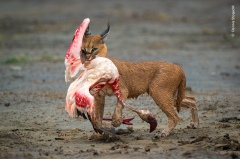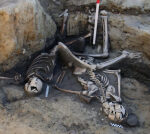
“Cat Amongst the Flamingo.” Dennis had been keeping an eye out for wild cats such as servals for several days when a call came over the radio: one had been seen at Ndutu Lake. But it wasn’t a serval. It was a caracal, successfully hunting wading lesser flamingos.
Caracals have a varied diet, from insects to antelope, and are renowned for the acrobatic leaps they make to snatch birds from the air. But there are few, if any, records of them hunting flamingos.
Credit: Dennis Stogsdill / Wildlife Photographer of the Year
Get the Popular Science daily newsletter💡
Breakthroughs, discoveries, and DIY tips sent every weekday.
At Serengeti National Park in Tanzania, a caracal chomps on its lunch of fresh flamingo. With an icy stare and pep in its step, the big cat skips away with the lifeless bird. This is the scene photographer Dennis Stogsdill witnessed and his image of the encounter earned top honors at the 2025 Wildlife Photographer of the Year awards in the “Behaviour: Mammals” category.
A record-breaking 60,636 entries from 113 countries and territories entered this year’s contest, now in its 61st year. South African wildlife photographer Wim van den Heever earned the prestigious title of Wildlife Photographer of the Year 2025 for his striking image, “Ghost Town Visitor” (seen below).

Winner, Urban Wildlife
Wim van den Heever (South Africa) photographs this haunting scene of a brown hyena among the skeletal remains of a long-abandoned diamond mining town.
With sea fog rolling in from the Atlantic Ocean, Wim chose this spot for his camera trap after noticing hyena tracks nearby. ‘It took me 10 years to finally get this one single image of a brown hyena, in the most perfect frame imaginable.’
The rarest hyena species in the world, brown hyenas are nocturnal and mostly solitary. They are known to pass through Kolmanskop on their way to hunt Cape fur seal pups or scavenge for carrion washed ashore along the Namib Desert coast.
Credit: Wim van den Heever / Wildlife Photographer of the Year 2025 Wim van den Heever
“This image is an eerie juxtaposition of the wild reclaiming human civilisation,” jury member Akanksha Sood Singh said. “The image is haunting yet mesmerising because the solitary hyena takes centre stage as a symbol of resilience amid the decay. This picture is a multi-layered story of loss, resilience and the natural world’s silent triumph, making it an unforgettable piece of wildlife and conservation photography.”
Wildlife Photographer of the Year is developed and produced by the Natural History Museum, London.

Winner, Behaviour: Birds
Qingrong Yang (China) perfects photographic timing to show a ladyfish snatching its prey from right under this little egret’s beak.
Qingrong was at Yundang Lake near his home, a place he visits regularly to photograph the feeding frenzies: little egrets patrol the surface, ready to pounce on fish leaping to escape underwater predators.
Once a natural marine harbour, Yundang Lake was sealed off from the sea during 1970s development. Isolated from the tides and currents, it became polluted and stagnant. An engineering project later reconnected it to the sea via a system of gates that regulate water flow.
Credit: Qingrong Yang / Wildlife Photographer of the Year YangQingRong

Winner, Animals in their Environment
Shane Gross (Canada) witnesses a peppered moray eel very much in its element hunting for carrion at low tide.
It took Shane numerous attempts over several weeks to document this rarely photographed behaviour. At first the eels were elusive, but once Shane realised that they were scavenging for dead fish, he waited. His patience was soon rewarded when these three eels appeared.
Peppered moray eels are well adapted to the intertidal zone. They can hunt both above and below the water’s surface using their keen senses of smell and sight, sometimes staying out of water for more than 30 seconds.
Credit: Shane Gross / Wildlife Photographer of the Year SHANE GROSS

Winner, Underwater
Ralph Pace (USA) beautifully illuminates the egg case of a swell shark, tethered to the base of a giant kelp.
Faced with strong currents pushing him from side to side, Ralph struggled to keep steady to photograph this egg case, or ‘mermaid’s purse’. He lit the case from behind to reveal the swell shark embryo within, its gill slits and yolk sac clearly visible among the dark kelp forest.
Researchers estimate that kelp forests in Monterey Bay have declined by more than 95 per cent over the past 34 years. Swell sharks depend on kelp to lay their leathery eggs, making them especially vulnerable to such losses.
Credit: Ralph Pace / Wildlife Photographer of the Year Ralph Pace

Winner, Rising Star Award
Luca had been watching a tree hole where this Eurasian pygmy owl and its mate were nesting. When one disappeared, the other continued feeding the chicks. On this day, the remaining bird returned clutching the chicks’ breakfast in its claws, and called for its mate, but there was no reply.
Credit: Luca Lorenz / Wildlife Photographer of the Year

Winner, Behaviour: Amphibians and Reptiles
Quentin Martinez (France) discovers a gathering of lesser tree frogs in a breeding event.
In persistent rain, Quentin followed a flooded path to a temporary pool in a forest clearing. He framed this scene with a wide-angle lens and used a diffused flash, which didn’t disturb the frogs, to highlight their metallic sheen.
To attract mates, lesser tree frogs produce short, shrill calls. Huge numbers gather, and the spectacular breeding event – triggered by heavy rains – lasts for just a few hours.
Credit: Quentin Martinez / Wildlife Photographer of the Year

Winner, Natural Artistry
Simone Baumeister (Germany) shows an orb weaver spider on its web on a pedestrian bridge, silhouetted by lights from the cars below.
To achieve this kaleidoscopic effect, Simone reversed one of the six glass elements in an analogue lens. This distorted the image at the edges while leaving the centre sharply focused. She then cropped the picture to move the spider slightly off-centre.
In urban environments, orb weaver spiders often spin webs near artificial lights that attract insects at night. The web acts as an extension of their sense organ, gathering sound and transmitting vibrations, including those of prey, to their legs.
Credit: Simone Baumeister / Wildlife Photographer of the Year Simone Baumeister

Winner, Rising Star Award
It was raining heavily on the small island of Heligoland, far out in the North Sea, when I walked along the shore, already completely soaked. I was hoping to photograph an animal in these heavy weather conditions, as I’m currently working on a rain series. I soon spotted a small group of harbour seals. They kept poking their heads out of the water of the North Sea, which was surprisingly calm at the time. Perfect to emphasize the thousands and thousands of raindrops falling on the surface of the water.





